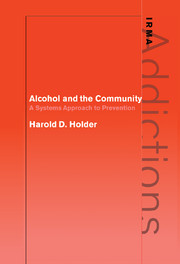Book contents
- Frontmatter
- Contents
- Series editor's preface
- Acknowledgements
- 1 The community system of alcohol use and alcohol problems
- 2 Consumption System
- 3 Retail Sales Subsystem: alcohol availability and promotion
- 4 Formal Regulation and Control Subsystem: rules, administration, and enforcement
- 5 Social Norms Subsystem: community values and social influences that affect drinking
- 6 Legal Sanctions Subsystem: prohibited uses of alcohol
- 7 Social, Economic, and Health Consequences Subsystem:community identification of and responses to alcohol problems
- 8 Community-level alcohol problem prevention
- References
- Index
3 - Retail Sales Subsystem: alcohol availability and promotion
Published online by Cambridge University Press: 22 September 2009
- Frontmatter
- Contents
- Series editor's preface
- Acknowledgements
- 1 The community system of alcohol use and alcohol problems
- 2 Consumption System
- 3 Retail Sales Subsystem: alcohol availability and promotion
- 4 Formal Regulation and Control Subsystem: rules, administration, and enforcement
- 5 Social Norms Subsystem: community values and social influences that affect drinking
- 6 Legal Sanctions Subsystem: prohibited uses of alcohol
- 7 Social, Economic, and Health Consequences Subsystem:community identification of and responses to alcohol problems
- 8 Community-level alcohol problem prevention
- References
- Index
Summary
Introduction
Alcohol is made available to consumers through the Retail Sales Subsystem. Alcohol may be legally or illegally produced. It is produced and distributed by a beverage industry (which may or may not be located within the community system) and sold in a variety of forms and quantities, through several types of retail outlets. Within the Retail Sales Subsystem, two key factors – retail availability and consumer demand for alcohol – interact to determine the level of retail sales of alcohol in a community, which is equivalent to the overall level of consumption.
In industrialized countries, the Retail Sales Subsystem is affected by the formal licensing and regulation of retail alcohol outlets. Restraints and restrictions on retail availability of alcohol, including zoning and other local regulation of alcohol outlets as businesses, are inputs to the Retail Sales Subsystem from the Formal Regulation and Control Subsystem. Even if, as in non-industrialized communities, alcohol is available through indigenous private production and sale, rather than formally licensed shops or bars and restaurants, such transactions still constitute a Retail Sales Subsystem.
The Retail Sales Subsystem for alcohol is a part of the community's overall retail marketplace. As part of the economic structure of a community, outlets for the sale of alcohol are influenced by the same types of economic factors that influence retail outlets for other non-durable (consumable or disposable) goods, such as food, clothing, motion pictures, cosmetics, and automobiles.
- Type
- Chapter
- Information
- Alcohol and the CommunityA Systems Approach to Prevention, pp. 54 - 63Publisher: Cambridge University PressPrint publication year: 1998

